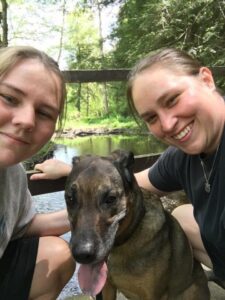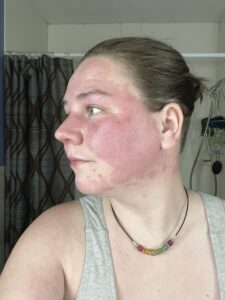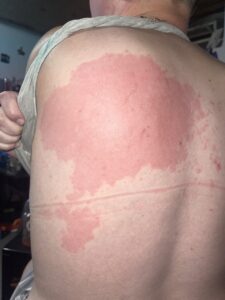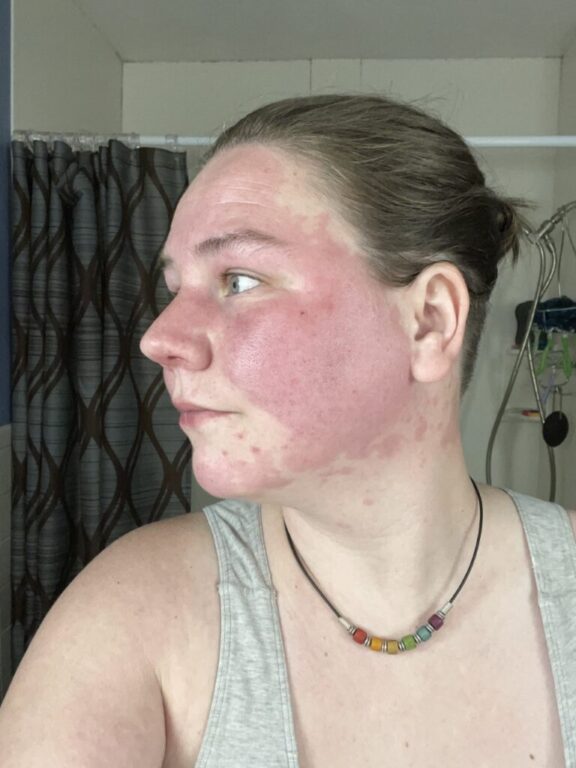At nearly 33 years old, Kyla McGaughey has overcome more challenges that many people can imagine. Her medical journey began in 2019 and it took over two years for her to receive a diagnosis of Gleich syndrome. Only 50 cases of Gleich syndrome are known worldwide, making Kyla part of an extremely small and complex group of patients. There is little research into Gleich syndrome or its management. In pursuing her treatments at NIH, Kyla is helping to discover and develop Gleich syndrome information that will be used to help patients for decades to come.
Although Kyla is currently on disability, as she frequently travels to the NIH for treatment, she is still doing all that she can to live a full and happy life. She is recently engaged and looking forward to what the future will bring for her and her fiancé. She is passionate about raising awareness and finding new avenues for connection. She shares:
“Awareness is one of the best things that we can do to help people and it’s in my power to do just that. When I was searching for a diagnosis, I struggled a lot with depression and self-confidence. I felt so alone and nobody around me seemed to believe what I was going through. It seemed like doctors thought I was faking my symptoms for attention. There are people out there who are going through something similar and are being either misdiagnosed or going undiagnosed. If doctors don’t know what to look for, they won’t be able to help. Raising my voice not only tells doctors to look for eosinophilia but serves as a reminder to others that they are not alone in this.”

Leading up to Rare Disease Day, Kyla sat down with Patient Worthy to share her diagnostic journey, what we know about Gleich syndrome so far, the challenges of living with an ultra-rare condition, and key advice for others who are dealing with a new diagnosis.
Kyla’s Story
One morning in May 2019, Kyla woke up and couldn’t move her wrist. Her entire left forearm was swollen; pain radiated through it, making it difficult to focus. As the pain became increasingly more debilitating, Kyla visited a walk-in clinic. Doctors were concerned that she had compartment syndrome, a very rare condition in which pressure within the muscles builds up, restricting blood flow and causing damage. Typically, compartment syndrome occurs after some sort of trauma or wound. Despite Kyla’s insistence that she had no injuries, the walk-in clinic told her to go to the emergency room.
At the emergency room, X-rays were taken, but the doctors seemed less concerned. They told Kyla to take ibuprofen and come back if the pain worsened. Two days later, the pain and inflammation were gone. But within a month, she woke up again with a tight, swollen arm. This time, however, her leg muscles also seemed tight and painful. Says Kyla:
“My legs and ankles cramped and locked up to the point where I was almost unable to walk. It felt like with every step, my legs got tighter and heavier. I couldn’t do more than shuffle and had to take many breaks. It was so scary as it was the first time that my body seemed to fail me.”
Similar to the first event, the symptoms receded after a few days. But the next few months brought increasing “flares” and more severe symptoms: both arms and legs locking and tightening, swollen and painful. Now concerned, Kyla began tracking her daily symptoms. She also began seeing a variety of doctors. She shares:
“I went to an endocrinologist who checked my thyroid, but that was normal. When I couldn’t eat anything without running to the bathroom or throwing up, I saw a GI doctor. They couldn’t figure anything out and gave me a general diagnosis of irritable bowel syndrome. I tried FODMAP diets and liquid diets, and even went dairy-free, but nothing helped. I even went to multiple rheumatologists. One tried to load me up with medicine without knowing what I had and the other said that he couldn’t treat me until I showed more symptoms.”
A Potential Lead
Five months after her initial flare, Kyla still had no answers as to what was going on with her health. The only lead that she and her doctors had was that a blood test showed high eosinophil levels. She shares:
“Eosinophils are a white blood cell type most notably triggered by allergens. Most people have a standard range of 15-500 cells per unit of them in their blood, whereas I had 3,000—sometimes over 10,000.”
Concerned about a possible oncologic problem, Kyla visited an oncologist to have her bone marrow tested. The test showed that she did not have cancer. At this point, Kyla did not know what to do. Her symptoms worsened:
“My body locked up and I was unable to get out of bed for days at a time because of the muscle swelling, hardness, and pain. My joints—ankles, knees, hips, shoulders, and wrists—would freeze up and I had searing pain whenever I moved them. Every once in a while, I would get swollen red splotches all over my body without any warning.”

For over a year and a half, Kyla kept visiting new specialists, hoping that someone could tell her what was going on. She wanted urgently to visit the Cleveland Clinic, but her insurance would not cover the costs. Finally, Kyla visited an allergist—and this is where her luck changed. The doctor knew of someone at the NIH who was part of an eosinophilia (an umbrella term for any condition marked by excess eosinophils) study. After the allergist made the connection, Kyla was asked if she would come in to speak to a doctor.
In October 2021, over two years after her symptoms first appeared, Kyla spent a few days at the NIH, undergoing multiple blood, skin, lung, and heart tests. She shared with the doctor her symptom log and was tentatively given a diagnosis of Gleich syndrome, also known as episodic angioedema with eosinophilia. For a more concrete diagnosis, she needed to track her eosinophils via blood tests over a six-week period. Once doctors noticed the cycle (peaks and valleys) of eosinophils in Kyla’s blood, the diagnosis was confirmed. Kyla shares:
“I will always be so grateful. Most of the doctors I’ve seen and spoken to since have never heard of Gleich syndrome. I don’t know what would have happened if he hadn’t helped me.”

Join us in Part 2 as we discuss what we know about Gleich syndrome so far and the challenges of living with an ultra-rare condition.







